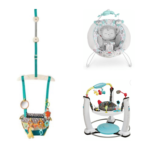We live in a time where most of us are go, go, go and multi-tasking to the max. This is especially true for those of us that are parents. We have a baby on our hip, while cooking dinner, checking the older kiddo’s homework, making the grocery list and folding laundry….ALL at the same time! Sound familiar? If we only had 6 hands! This is why we often find ourselves putting our babies in positioning devices, or containers, to keep them safely in one place while we complete our daily tasks. Manufacturers have recognized this need and bombarded us with a myriad of options on the market. These include:
- Infant carriers such as slings and packs
- Nursing pillows
- Infant swings
- Floor seats, car seats and high chairs
- Exersaucers, jumpers or walkers
Although these containers in most cases offer a safe solution for positioning, extended time throughout the day in any or multiple of these items may lead to issues currently referred to as “Container Baby Syndrome”. Time in a container can quickly add up throughout the day if a child rides in a car seat, falls asleep in a swing, sits in a high chair then stands in a baby walker or other such equipment. From the early days of infancy, our babies are hardwired to want to move and explore their environment. They look and touch, kick and reach, roll, sit and crawl. Their little baby hands want to touch and feel everything. Their little eyes want to closely explore every crack and crevice and crumb or piece of lint on the floor. These devices by their very nature are meant to block this exploration. Some issues that may arise from “Container Baby Syndrome” include:
- Flat spots on their heads (plagiocephaly)
- Neck tightness – a preference for looking to only one side of their bodies (torticollis)
- Delayed gross motor skills including rolling, sitting, crawling and walking – a baby develops strength and coordination as they wiggle and move against gravity. Their little baby muscles don’t get their workout when they are placed in a device that holds them in one position.
- Delayed fine motor skills and hand-eye coordination due to decreased opportunities to reach, grasp and explore objects with their hands.
From one busy mama to another, some ideas for positioning to prevent “Container Baby Syndrome”:
- Place baby on the floor, ideally on their tummy, as often as you can – lay a blanket on the floor right beside you while you are doing your chores. Baby will enjoy watching you do the dishes or fold the laundry. Talk to them and sing to them as you work.
- Place them in a seated position in the corner of your couch, while you sit next to them.
- Place them in a seated position on the floor, with a boppy pillow around their hips to support them.
- Gate off a safe area that has been baby proofed and offers stable surfaces to climb on, pull to stand at or cruise along
- If needing to use a container, limit their time in the container to 20 minutes.

